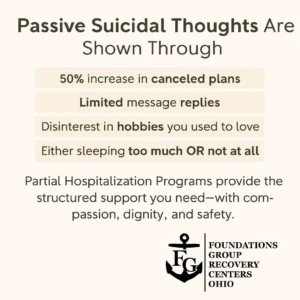I didn’t realize how long I’d been disappearing.
Not physically.
Physically, I was still sitting at my desk. Still showing up to family dinners. Still texting people back with emojis that felt like lies. Still laughing at things I didn’t think were funny.
But somewhere underneath the surface, a part of me was fading. Slowly. Quietly. Like a dimmer switch being turned down one notch at a time.
I wasn’t planning anything.
I wasn’t in danger in the way people imagine when they hear the word “suicidal.”
I was just tired.
Numb.
Worn down by the constant effort of pretending this life didn’t feel too heavy.
And the scariest part?
I didn’t want to die.
But I also didn’t want to keep living like that.
That in‑between place — the space where you’re technically functioning but emotionally slipping — is where I lived for months. And because nothing dramatic was happening on the outside, I convinced myself it wasn’t “bad enough” to get help.
The silence felt safer.
Less embarrassing.
Less disruptive.
Until it wasn’t.
It was a therapist who gently said the words:
“You’re carrying too much alone. You don’t have to keep doing this without support.”
She suggested a Partial Hospitalization Program.
My first reaction was: That sounds too serious for me.
But when I walked into the Partial Hospitalization Program in Upper Arlington, something in me exhaled for the first time in months.
The Kind of Pain You Can Hide in Plain Sight
People don’t talk enough about quiet suicidal ideation.
You don’t collapse.
You don’t cry all day.
You don’t scream for help.
You just… slip.
You start canceling plans because everything feels too loud.
You stop answering messages that require more than one-word replies.
You shower less.
Eat less.
Sleep more… or not at all.
You lose interest in the things you used to love — slowly enough that people chalk it up to “stress” or “being busy.”
And because you can still technically function, no one thinks anything’s wrong.
That’s the trap.
The silence grows roots.
I wasn’t afraid of hurting myself.
I was afraid of burdening people with how much I hurt.
So I kept it in.
Nodded along.
Stayed on autopilot.
Until the autopilot started glitching.

Why PHP Was the First Place I Didn’t Have to Hide
PHP gave me what I didn’t know I needed:
A soft place to land that didn’t require me to be in full crisis.
It wasn’t a hospital.
It wasn’t inpatient.
It wasn’t a locked ward or a “you’re not okay” label.
It was a quiet room, a comfortable chair, a group of humans who understood that mental pain doesn’t need to look dramatic to be real.
A typical day was structured, but not rigid:
- Morning grounding sessions
- Therapy that moved at my pace
- Group conversations that reminded me I wasn’t strange or weak
- Breaks that allowed me to breathe without stuffing my emotions back inside
- Time to reflect
- Support that didn’t ask me to justify my pain
There was no pressure to spill everything.
No one demanded explanations.
No one treated me like an emergency to be managed.
They treated me like a human who was hurting — and trying.
Saying It Out Loud Didn’t Shatter Anything
The first time I said, quietly,
“I’ve been having thoughts about not wanting to be here,”
I expected everything to break.
I expected panic. Shock. Alarms. A long lecture.
Instead, my therapist just nodded gently and said,
“Thank you for trusting me with that. Let’s slow down and sit with it.”
Not rush.
Not fix.
Just sit.
That moment changed everything.
There’s something powerful about being witnessed without being judged.
Something healing about speaking the thing you’ve feared — and realizing the world stays steady.
In PHP, I learned that telling the truth isn’t dangerous. Keeping it in often is.
PHP Gave Me the First Real Stability I’d Felt in Years
Mental pain creates chaos.
Not dramatic chaos — quiet chaos.
The kind that lives inside your routines, your thoughts, your habits.
PHP helped calm that chaos.
I learned:
- How to recognize the early signs of emotional shutdown
- How to soothe myself without disappearing
- How to understand suicidal thoughts without panicking or spiraling
- How to create daily safety plans that made overwhelming days feel survivable
- How to let people support me without feeling like a burden
- How to talk about the pain instead of swallowing it
The routine didn’t erase everything.
But it made the days feel less like cliffs and more like hills.
And hills, unlike cliffs, can be climbed.
You Don’t Have to Be on the Edge to Deserve Help
I used to think PHP was only for people in visible crisis.
But Foundations’ team in Columbus, Ohio taught me something life-changing:
Pain doesn’t need to be loud to be worthy of care.
You don’t need a plan.
You don’t need an attempt.
You don’t need a breakdown.
You don’t need a dramatic moment.
You just need to be struggling.
That’s enough.
What I Found in PHP That I Couldn’t Find Alone
- A place to slow down without checking out
- People who understood the numbness that scared me more than sadness
- Language for emotions I’d been avoiding
- Tools to keep myself grounded during spirals
- A routine that didn’t feel like punishment
- Quiet hope — the kind that sneaks in when you’re not looking
PHP didn’t “fix” me.
It helped me stay.
And sometimes, staying is the bravest thing you can do.
Looking for a Partial Hospitalization Program in Franklin County?
If you’re in that quiet, heavy place — not wanting to die but not knowing how to keep going — the program at Foundations in Franklin County might be the most compassionate next step you can take.
No pressure.
No judgment.
Just space, support, and people who don’t get scared when you tell the truth.
The First Time I Felt Hope Again
Not excitement.
Not joy.
Not inspiration.
Hope.
Small.
Gentle.
Barely there.
A thought whispered during a break between sessions:
“Maybe there’s a way to live that doesn’t feel like this.”
That was enough to keep going.
That was enough to stay.
That was enough to rebuild.
FAQs: Partial Hospitalization & Suicidal Thoughts
Do I need to be actively suicidal to enter PHP?
No. Many PHP clients experience passive suicidal ideation, emotional numbness, or deep exhaustion — not active intent.
Will PHP lock me in or take away my freedom?
No. PHP is not inpatient. You go home each day. The goal is support, not restriction.
What if I’m scared to say the words?
You don’t have to say everything at once. Your team will move at your pace and help you feel safe talking about what’s hard.
Will I be judged if I admit I’m struggling?
Not at Foundations. Suicidal thoughts are treated with compassion and understanding — never shame.
What does a full day in PHP look like?
You’ll attend groups, meet with therapists, learn grounding and coping skills, and have structured breaks. It’s steady, not overwhelming.
What happens after PHP?
You’ll work with your team to create a step‑down plan: outpatient therapy, IOP, medication support, or whatever helps you stay steady.
If you’re tired of carrying everything alone, you deserve support.
Call (888)501-5618 to learn more about our Partial Hospitalization Program services in Upper Arlington, OH.
You don’t have to disappear to be taken seriously.
You don’t have to be alone inside your own mind.
You’re allowed to stay — and to feel safe staying.
